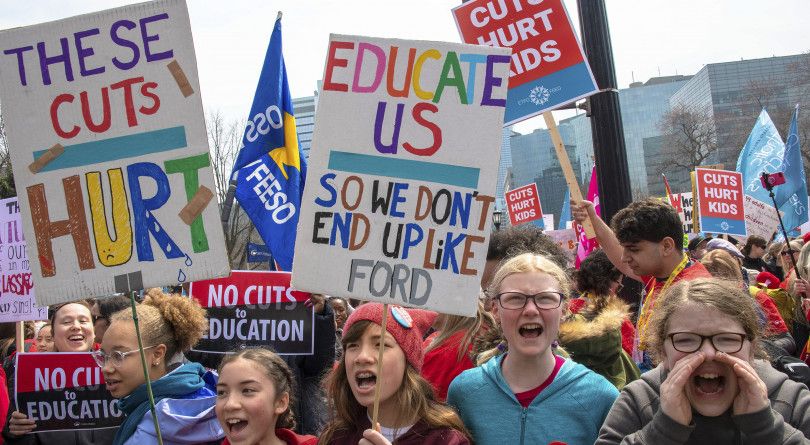Tim Heffernan is a retired Ontario Teacher.
Two months after the first one day strike by Ontario High School Teachers, the two sides are still miles apart. (This article gives background to the strike.)
The High School teachers in the public boards, organized by OSSTF, were the first to take action with a series of one day rotating strikes – one group of School Boards targeted first, followed by another group. This was in December. In January, the public elementary teachers, ETFO (largest of the 4 unions) joined the fray with a similar type of rotating strike. Then, in early February, the union for teachers in the public Catholic Boards, OECTA, came on board. Finally, the union representing French language teachers in both Catholic and public boards, AEFO, also joined the action, announcing one day strikes from mid February. This will mark the first time that all the Ontario teacher unions have taken joint action since the historic two week strike/political protest of 1997 against the Mike Harris government. In addition the unions have been conducting various forms of work to rule, such as not participating in extracurricular activities or field trips.
It’s all about the money?
Premier Doug Ford and Education Minister Lecce thought they could divide teachers and get the public on the government’s side by portraying teachers as only looking out for themselves and not the students (“they’re only interested in getting a 2% pay hike”). In addition, the Ford government, in mid-January, offered a payment (many parents called it a bribe) of up to $60 a day for when strike actions closed schools or school-based child care centres. Note that the financing of these payments comes from unpaid wages to the striking teachers.
Minister Lecce declared, “While unions impose hardship on families and students, our government is taking proactive steps to ensure students remain cared for – and families supported – in the event that unions decide to further escalate job action in their fight for enhanced compensation and other demands. The contrast could not be clearer.” A parent on twitter commented, “So, let’s just get this straight. We don’t want to pay Ontario teachers the 2% they are asking, BUT we are fine spending $60 a day for everyone who puts their kids in child care. Roughly 2 million students in Ontario. So even a one day strike could cost $130,000,000.”
Another twitter comment: “The Ford Government paid $25,000,000 today in childcare bribe money. They could have paid for 961 Educational Assistants for A FULL YEAR with that money! Imagine how many children would benefit from an E.A.’s one on one attention and support.”
Three weeks into the bribe, Ministry figures showed that three-quarters of those eligible hadn’t yet applied for payouts. Some parents have applied for the payment and have decided to donate it back to their local school or community organization.
Who’s winning public opinion?
Since June, Ford has been well aware of his (and his government’s) slumping levels of popularity. It started with the crescendo of boos that greeted him at the time of the Toronto Raptors’ victory parade. That was followed by his virtual disappearance in the general election campaign in order not to damage Andrew Scheer’s chances (an epic fail). Following the election, Ford has almost become “a new man” – gentler, less in your face, less combative, more conciliatory – at least, in words.
This has not had the effect of improving the government’s public standing. In a poll taken in early January, respondents sided with the teachers by a margin of nearly two to one, in spite of the fact that OSSTF had already held two one-day strikes affecting hundreds of thousands of families, and members of all four Ontario teachers’ unions were working to rule. In addition to the public, most students are supportive of the teachers. Melissa, a Grade 10 student at one of the Catholic High Schools in Toronto, said that, despite problems that some of the Grade 12s were having with marks for University, most students supported the teachers. She would like to see the teacher unions organize a public rally where students could show their support.
Despite the government’s attempt to spin its messaging to the 2% salary increase, the unions have been largely successful in focusing on the issues of reversing the cuts, maintaining current class sizes, preventing mandatory e-learning, and winning additional resources to deal with workplace violence, harassment and serious student incidents.
Ford cuts funding
Across the province, per-student funding has been reduced by $375 on average, or 3% in real terms. In addition, there have been changes to the Learning Opportunities Grant (LOG). Initially set up to assist students living in situations that increase the chances of lower academic achievement, i.e. aimed at poor and working class students, this grant has been increasingly used to fund a variety of programs, including supports for students with learning disabilities. The 2019-2020 funding estimates include a 36% cut to the LOG grant compared to 2017-2018, adjusted for inflation. Some boards face cuts as large as 76% (York Catholic District School Board).
Which way forward?
When Socialist Alternative wrote on this subject last December, only one union, OSSTF, was taking strike action. We said, “The question is posed of raising the bar to rotating strikes and/or an all out indefinite strike. That, of course, raises the likelihood of the government introducing back to work legislation. The big question – does the union leadership have a plan B for that eventuality? If OSSTF is going to successfully deal with this issue, it is essential to have a co-ordinated strategy with the other education unions …… But even an all round, consolidated and integrated union action may not be enough as the 1997 political protest against the Mike Harris government demonstrated.”
The co-ordinated action has certainly happened since then and the union leaders are to be congratulated for that. The one day strikes of the different unions has kept the pressure up, has raised the confidence of the rank and file, and has not led to an erosion of public support. But can this strategy last indefinitely? It’s quite possible, given the mood of teachers and the support of the public, that the government will blink first. However, the other side of the picture is that it may need further prodding, in the form of an all out indefinite strike, to make the government blink.
We wrote in December, “in anticipation of a government plan to bring in back to work legislation in the event of an all out strike, approaches need to be made now to the Ontario Federation of Labour with a view to getting commitments from the wider labour movement for solidarity action.”
We concluded, “The teachers are fighting a just cause and they have the public on their side. Using a bold and astute strategy, they could be making a major stand in defence of public education while, at the same time, inflicting a fatal blow to the Ford government.” That perspective still holds.



